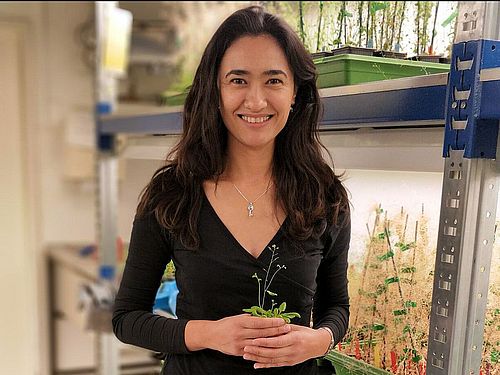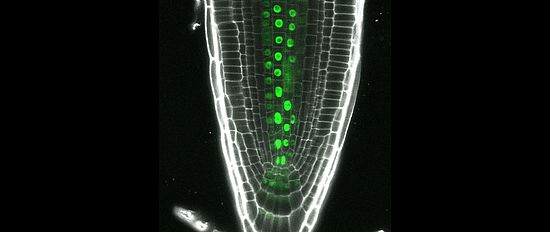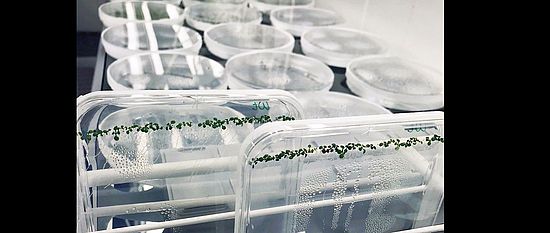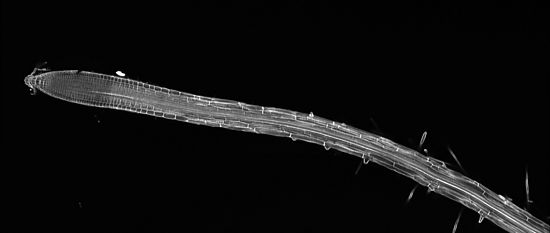Signaling peptides in plant adaptation to abiotic stresses
Molecular Genetics and Plant Cell Biology
Multicellular organisms cope with the challenge of maintaining efficient communication between different organs and tissues to coordinate growth and responses to the environment. Both, plants and animals produce biologically active compounds such as small peptides that move between cells through the vascular system or intercellular spaces and regulate plethora of developmental processes and stress responses. In plants, in addition to major hormones, a myriad of secreted peptides orchestrates optimal growth and adaptation to environmental changes. Our lab is interested to unravel the functions of the CLAVATA3/EMBRYO SURROUNDING REGION (CLE) peptides and their cognate receptors in the control of the water conducting tissue formation and in the plant adaptation to abiotic stresses. In addition, we aim to develop new tools to tag and track the precursors and mature CLE peptides in planta. In collaboration with structural biology and organic chemistry laboratories as well as with our Proteomics Platform at UniFR, we use a combination of genetic approaches, molecular design, proteomics, cell biology, high-resolution confocal microscopy and plant physiology assays.
Recent Publications
- Understanding the root xylem plasticity for designing resilient crops
Cornelis, Salves; Hazak, Ora
Plant Cell And Environment 10.1111/pce.14245 MAR 2022 - BAM1/2 receptor kinase signaling drives CLE peptide-mediated formative cell divisions in Arabidopsis roots
Crook, AD; Willoughby, AC; Hazak, O; Okuda, S; VanDerMolen, KR; Soyars, CL; Cattaneo, P; Clark, NM ; Sozzani, R; Hothorn, M; Hardtke, CS; Nimchuk, ZL
Proceedings Of The National Academy Of Sciences Of The United States Of America 10.1073/pnas.2018565117 DEC 22 2020 - A novel Ca2+-binding protein that can rapidly transduce auxin responses during root growth
Hazak, O; Mamon, E; Lavy, M; Sternberg, H; Behera, S; Schmitz-Thom, I; Bloch, D; Dementiev, O; Gutman, I; Danziger, T; Schwarz, N; Abuzeineh, A; Mockaitis, K; Estelle, M; Hirsch, JA; Kudla, J; Yalovsky, S
PLOS BIOLOGY, 17 (7):10.1371/journal.pbio.3000085 JUL 2019 - A Cellular Insulator against CLE45 Peptide Signaling
Breda, AS; Hazak, O; Schultz, P; Anne, P; Graeff, M; Simon, R; Hardtke, CS
CURRENT BIOLOGY, 29 (15):2501-+; 10.1016/j.cub.2019.06.037 AUG 5 2019 - Perception of root-active CLE peptides requires CORYNE function in the phloem vasculature
Hazak, Ora; Brandt, Benjamin; Cattaneo, Pietro; Santiago, J; Rodriguez-Villalon, A; Hothorn, M; Hardtke, CS
EMBO REPORTS, 18 (8): 1367-1381 https://doi.org/10.15252/embr.201643535 AUG 2017 - Phosphosite charge rather than shootward localization determines OCTOPUS activity in root protophloem
Breda, Alice S.; Hazak, Ora; Hardtke, Christian S.
PROCEEDINGS OF THE NATIONAL ACADEMY OF SCIENCES OF THE UNITED STATES OF AMERICA 114(28): E5721-E5730 10.1073/pnas.1703258114 JUL 11 2017 - CLAVATA 1-type receptors in plant development
Hazak, Ora; Hardtke, Christian S.
JOURNAL OF EXPERIMENTAL BOTANY 67 (16), SI:4827-4833 10.1093/jxb/erw247 AUG 2016 - Bimodal regulation of ICR1 levels generates self-organizing auxin distribution
Hazak, Ora; Obolski, Uri; Prat, Tomas; Friml, J; Hadany, L; Yalovsky, S.
PROCEEDINGS OF THE NATIONAL ACADEMY OF SCIENCES OF THE UNITED STATES OF AMERICA 111 10.1073/pnas.1413918111 2014

Dr. Ora Hazak
University of Fribourg
Department of Biology
1700 Fribourg
Tel: +41 (0)78 952 9996
Research Topics
- Plant signaling peptides and receptors
- Xylem development
- Adaptations to abiotic stresses
Interdisciplinarity
- Developing tools to tag and track CLE peptides in vivo (in collaboration with Dr. Roy Weinstain, Tel Aviv University, Israel)
- Testing the glycosylation of the receptors (in collaboration with Dr. Sabina Gerber, ZHAW, Zurich)
- Peptides detection methods (Proteomics platform, UniFR)




